Stabilized Step Function Opsin Proteins and Methods of Using the Same
- Summary
- Abstract
- Description
- Claims
- Application Information
AI Technical Summary
Benefits of technology
Problems solved by technology
Method used
Image
Examples
example 1
Creation and Characterization of the Stabilized Step Function Opsin
[0135]Long-timescale (indeed bistable) optogenetic tools were initially developed that operate on timescales up to 4 orders of magnitude longer than that of wild type (wt) ChR2 (SFO or step function opsin gene products; -r-off=2.5-102 seconds); these mutations at the C128 position of ChR2 led to increased light sensitivity that scaled with the deactivation time constant. Subsequent work further developed the initial SFO concept, with mutation of the C128 proton networking partner D156 (FIG. 1A) for extension of the photocycle and lifetime of the open state. However, neither class of mutation gives rise to full stability on the mammalian-behavioral timescale-both showing substantial decay during the first 5-10 min- and extended illumination of SFO-expressing neurons in some cases can lead to channelrhodopsin inactivation caused by deprotonation of the chromophore and accumulation of a photocycle side product in a side...
example 2
Validation of Activation in Neurons and In Vivo
[0141]The double mutant therefore appeared to have markedly distinct and near-optimal stability on the mammalian behavioral timescale, but with potentially reduced crucial capability for redshifted light deactivation; all of these issues required validation in neurons and in vivo.
[0142]Materials and Methods.
[0143]Whole Cell Patch-Clamp Electrophysiology in Hippocampal and Cortical Neurons
[0144]Primary hippocampal cultures were isolated from PO Sprague-Dawley rats, plated on Matrigel (Invitrogen)-coated glass coverslips and treated with FUDR to inhibit glia overgrowth. Endotoxin-free plasmid DNA was transfected in cultured neurons using a HEPES buffered Saline / CaPO4 mix. Electrophysiological recordings from individual neurons identified by fluorescent protein expression were obtained in Tyrode media ([mM]150 NaCl, 4 KCl, 2 MgCl2, 2 MgCl2, 10 D-glucose, 10 HEPES, pH 7.35 with NaOH) using a standard internal solution ([mM] 130 KGluconate, ...
example 3
Effects of SSFO on Behavior and Circuit Dynamics in Freely Moving Mice
[0154]Having established that SSFO can be used to bi-directionally modulate prefrontal excitability on behaviorally-relevant time scales SSFO was used to examine the effects of elevated cellular E / I balance on behavior and circuit dynamics in freely moving mice (FIG. 3). SSFO was expressed either in prefrontal cortical excitatory neurons using the excitatory neuron-specific CaMKIIα promoter, or in inhibitory parvalbumin (PV)-expressing neurons using a double-floxed, inverted open-reading-frame (DIO) virus in conjunction with PV::Cre transgenic mice (FIG. 3J-L). Virus was injected in mPFC as described above, followed by a chronic fiber-optic implant that projected past the skull immediately dorsal to mPFC for light delivery (FIG. 3A, B).
[0155]Materials and Methods
[0156]Mutual Information Calculations
[0157]To study the effects of SSFO on sEPSC-spike rate information, whole-cell patch recordings were conducted from v...
PUM
| Property | Measurement | Unit |
|---|---|---|
| Fraction | aaaaa | aaaaa |
| Intrinsic viscosity | aaaaa | aaaaa |
| Responsivity | aaaaa | aaaaa |
Abstract
Description
Claims
Application Information
 Login to View More
Login to View More - R&D
- Intellectual Property
- Life Sciences
- Materials
- Tech Scout
- Unparalleled Data Quality
- Higher Quality Content
- 60% Fewer Hallucinations
Browse by: Latest US Patents, China's latest patents, Technical Efficacy Thesaurus, Application Domain, Technology Topic, Popular Technical Reports.
© 2025 PatSnap. All rights reserved.Legal|Privacy policy|Modern Slavery Act Transparency Statement|Sitemap|About US| Contact US: help@patsnap.com



